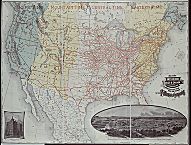|
Map of Pullman Rail Network, 1885

|
Toward the end of the 1850s, George M. Pullman of Chicago began to remodel passenger coach railroad cars. The Pullman's Palace Car Co. was incorporated in Illinois in 1867; its first manufacturing shops were located in Detroit and Elmira, New York. By 1877, it operated about 460 luxury passenger cars, service on which was supervised by white conductors and African American porters. In 1880, Pullman decided to build a new manufacturing plant and a company town on a site about 14 miles south of downtown Chicago. By 1885, the population of the town had risen to nearly 9,000 men, women, and children. In the early 1890s, nearly 6,000 of the company's 14,000 employees nationwide worked in Pullman, where annual output stood at about 12,000 freight cars and 1,000 passenger cars. After an economic downturn in 1893, the company laid off thousands of workers; Pullman employees responded in 1894 by going on strike. This strike soon had national effects, because tens of thousands of American Railway Union members showed their support for Pullman workers by launching a boycott of trains pulling Pullman cars. In 1898, the Illinois courts ordered the company to sell its non-factory lands in the town. The company, however, continued to grow. By 1900, when the company changed its name to Pullman Co. after acquiring the assets of its only real competitor, the main plant had nearly 6,000 employees and produced about $14 million worth of railroad cars per year. Ten years later, when the company completed its transition from wooden cars to steel cars, there were about 10,000 workers at the Pullman plant. Meanwhile, the company operated about 7,500 passenger cars, which it leased—complete with porters and other workers—to railroad companies around the world. During the 1920s, when the workforce at Pullman reached a peak of about 20,000 people, the company was reorganized. In 1927, a holding company called Pullman Inc. was established to oversee two separate divisions: the Pullman Car & Manufacturing Corp., the company's manufacturing division, and the Pullman Co., which operated the world-famous passenger cars. The latter company's labor policies gave birth to the Brotherhood of Sleeping Car Porters. In 1929, Pullman Car merged with the Standard Steel Car Co. (another leading railroad car maker), creating the Pullman-Standard Car Manufacturing Co., which had plants in Hammond and Michigan City, Indiana, as well as other U.S. locations. During the 1930s, Pullman-Standard was the nation's largest manufacturer of freight cars and passenger cars. After World War II, the U.S. Department of Justice forced Pullman Inc. to sell one of its two divisions. The operating company, which kept the Pullman Co. name, was purchased by a group of railroad companies. Pullman Inc. kept Pullman-Standard, which declined steadily through the 1970s, by which time it was no longer an important manufacturer of railcars. In 1977, Pullman Inc., still based in Chicago, had annual revenues of $2 billion and employed 32,000 people nationwide. In 1980, Pullman Inc. was purchased by Wheelabrator-Frye Inc., a New Hampshire–based conglomerate. Two years later, the Pullman Car Works closed. Most of its rail-car manufacturing assets and its remaining freight car plants were subsequently sold to Dallas-based Trinity Industries.
Martha T. Briggs and and Cynthia H. PetersThis entry is part of the Encyclopedia's
Dictionary of Leading Chicago Businesses (1820-2000)
that was prepared by Mark R. Wilson, with additional contributions from Stephen R. Porter and Janice L. Reiff.
|
